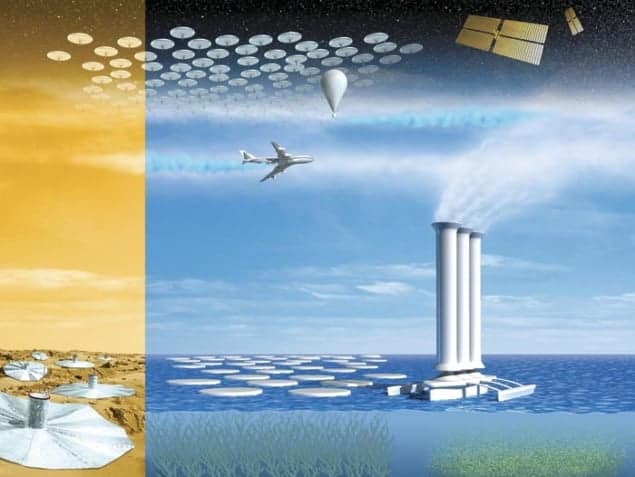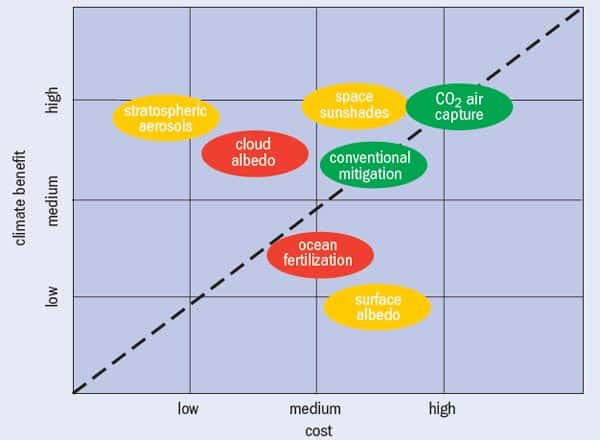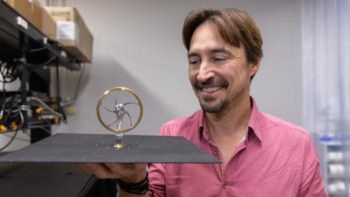Geoengineering has so far been something of a taboo topic for climate scientists. Peter Cox and Hazel Jeffery explain why it is now time to take it seriously

The climate change we are experiencing now is caused by an increase in greenhouse gases due to human activities, most notably the burning of fossil fuels, agriculture and deforestation. Although global warming has been around in the scientific literature since a landmark paper by Swedish physicist Svante Arrhenius in 1896, it has only been in recent decades that our scientific understanding of the climate system has made it clear that a global warming of greater than 2 °C above pre-industrial levels may be dangerous and should therefore be avoided.
While greenhouse gases include not only carbon dioxide (CO2) but also methane, nitrous oxide, ozone and CFCs, international political negotiations have focused on the need to reduce CO2 emissions. In three months’ time, the 15th Conference of the Parties (CoP15), part of the United Nations Convention on Climate Change in Copenhagen, will aim to set binding targets for emission reductions (so-called conventional mitigation). But even if global CO2 emissions are cut by 50% by 2050, this now seems unlikely to be enough to keep global warming below 2 °C this century. Indeed, since the Kyoto protocol to limit greenhouse gases was established in 1997, global CO2 emissions have continued to climb despite growing concerns over climate change. Given that conventional mitigation now appears insufficient to avoid dangerous climate change, do we have a plan B? This is the motivation for geoengineering, a term that describes deliberate intervention in the climate system to counteract man-made global warming. This can be achieved in two ways, by direct removal of carbon dioxide and by solar-radiation management, which aims to cool the planet by reflecting more sunlight out into space.
Removing carbon dioxide
The most obvious approach to CO2 removal is to plant forests, but this is relatively inefficient and requires large areas of land. A more radical suggestion is to fertilize the ocean with a limiting nutrient such as iron in the hope of enhancing the oceanic carbon sink (which currently absorbs about 25% of man-made CO2 emissions). Small-scale ocean-fertilization experiments have produced artificial phytoplankton blooms through the addition of iron, but it is questionable whether this will translate into a long-term enhancement of the carbon sink. A major risk with this approach is that ocean currents make it impossible to contain the area over which ocean ecosystems are modified by the addition of nutrients.
A safer method of removing carbon dioxide is air capture, which involves chemical or physical extraction of CO2 from the air and burial of the carbon in geological stores. The storage part of this approach is similar to conventional carbon capture and storage, which aims to remove the CO2 from the exhaust gases of fossil-fuel power stations. Air capture can in principle be carried out at any location, although it is most useful close to the geological stores. Chemical methods of air capture typically involve the reaction of carbon dioxide with sodium hydroxide to produce sodium carbonate, whereas physical capture involves ion-exchange resins that are able to filter CO2 from the air, which can subsequently be washed from the filters with water. There are major advantages to air-capture techniques because they remove the primary cause of global warming and, unlike conventional mitigation, offer the possibility of reducing CO2 concentrations below current levels. However, these techniques are currently expensive and carry the associated difficulties of finding suitable stable geological stores for the carbon.
Blotting out the Sun or brightening the planet
An alternative to the removal of carbon dioxide is solar-radiation management, which involves reducing the amount of sunlight absorbed by the Earth as a whole. The global mean temperature of the planet is determined by the balance between the solar radiation absorbed and the infrared radiation lost by the Earth to space. It is possible to cool the planet by either increasing the amount of infrared radiation lost to space (as in the CO2 removal techniques) or by reducing the amount of solar radiation absorbed by the planet. Managing solar radiation involves either blotting out a fraction of the sunlight using space-based sunshades or increasing the brightness (albedo) of the planet.
There are various techniques for surface-based solar-radiation management: the so-called white-roof approaches, in which human settlements, predominantly roofs and pavements, are painted with reflective materials; selection of brighter crop and pasture plant species; and even more radical plans that would involve covering the deserts with highly reflective plastics. The climate benefits of these techniques vary with the area modified. For example, white-roof approaches have a relatively small impact on global mean temperature, because human settlements still only cover about 2% of the global land area. On the other hand, large-scale modification of plant albedos could yield a global cooling sufficient to offset global warming to date, but other more urgent pressures on agricultural productivity probably make this approach impractical. Brightening of the deserts could have an even greater cooling effect, but such localized forcing of the climate system carries the risk of changing critically important atmospheric circulations, such as the monsoons that bring rainfall to significant fractions of the Earth’s population.
Similar risks are associated with techniques to brighten the clouds, since these will obviously operate only where the clouds exist. However, modifying cloud albedo is a potentially large lever on the climate that could provide a global cooling to offset a doubling of atmospheric carbon dioxide. The most advanced cloud-modification proposal involves whipping up additional sea salt to provide extra cloud-condensation nuclei that would make marine stratocumulus clouds brighter – these are the lower-altitude clouds over the coastal regions and oceans. The cloud-modification proposal has gone as far as designs for the automated ships that would deliver the extra sea salt to the stratocumulus clouds. The costs involved with this approach are unclear, but they are likely to be significantly less than a similar cooling produced by conventional mitigation.
An even cheaper technique may be to mimic the climatic impacts of major volcanic eruptions by injecting particulates or “aerosols” into the Earth’s stratosphere (upper atmosphere). These aerosols would reflect additional sunlight just as they did after the eruption of Mount Pinatubo in 1991, which led to a global cooling of about 0.5 °C. Ideas of this type probably originated with the Russian physicist Mikhail Budyko in the 1970s, who suggested using sulphur as the basis for the stratospheric aerosols as is the case for volcanic eruptions. The notion of geoengineering through stratospheric aerosols was subsequently pursued in the 1990s by physicist and H-bomb inventor Edward Teller, who envisaged more-sophisticated reflecting particles. But the discussion of geoengineering proposals remained taboo among mainstream climate scientists until 2006, when chemistry Nobel laureate Paul Crutzen reassessed the utility of injecting sulphur into the stratosphere in the light of the climatic effects of the Pinatubo volcanic eruption. Concerns remain about uncertainties in the regional response of rainfall to the combination of elevated CO2 and reduced sunlight, and in the potential impact of additional aerosols on the recovery of the hole in the ozone layer. However, the estimated costs of maintaining a sulphate aerosol shield, most likely through a small number of dedicated high-flying aircraft, are remarkably cheap compared with the costs of conventional mitigation by factors of hundreds or even thousands. For that reason, stratospheric aerosol techniques are considered by many to be the most promising alternative to conventional mitigation.
The most sci-fi of the techniques for solar-radiation management involves placing sunshades between the Sun and the Earth. The most promising sunshade position appears to be at the L1 Lagrange point, which is the position about 1.5 × 106 km from Earth towards the Sun, where the gravitational attraction of the two bodies cancel. At this point, sunshades of about 3 × 106 km2 would be required to counteract a doubling of CO2. There are formidable challenges associated with the design and manufacture of light, durable materials that could be used for the sunshades, but the primary long-term costs are likely to be associated with the launch of the elements of the sunshades and their routine repair and replacement. Even if such a geoengineering approach proved to be technologically and economically feasible, there are massive international governance issues to be negotiated before implementation. Such issues are also common to the other large-scale techniques such as desert-albedo modification, cloud-albedo modification and stratospheric aerosol injection, all of which involve cooling the global climate but will not offset all regional climate changes and could even exacerbate changes in some regions. In addition, techniques based on managing solar radiation obviously do not deal with the uncertain effects of ocean acidification due to increasing CO2.
Lifting the taboo
According to the Stern Review, which was published in 2006 and is one of the most influential documents on the economics of climate change, using conventional mitigation to avoid a potentially dangerous 2 °C global warming would cost up to 1% of global gross domestic product, about $350bn per year at current prices. The figure above summarizes the potential of the various geoengineering proposals based on an assessment published by the Royal Society this month. In addition, it compares each of the techniques against conventional mitigation, as this represents the most obvious solution to global warming and is at the heart of international climate negotiations.
Geoengineering alternatives can be assessed based on annual costs, benefits in terms of the reduction in global mean temperatures and the risks associated with each technique. These factors are shown schematically in the figure. While some approaches, such as ocean fertilization or white-roof techniques, can be ruled out because they are unlikely to have a significant global climate benefit, most of the geoengineering proposals appear cheap compared with conventional mitigation. More importantly, many have a higher climate benefit to annual cost ratio than conventional mitigation (i.e. they lie above the dotted line).
The benefit-to-cost ratio appears largest for stratospheric aerosol injection, although this carries the risks of regional climate change and delaying the recovery of the hole in the ozone layer. In addition, highly effective techniques for solar-radiation management such as sulphur aerosol injection carry what is sometimes called “termination risk”, that is the risk of sudden global warming in the event of failure of the geoengineering. The flip side to this termination risk is that such approaches can be deliberately switched off if unintended consequences emerge.
The safest alternative to conventional mitigation is CO2 air capture, which removes the primary cause of global warming and therefore avoids the risks associated with termination, regional climate change and ocean acidification. Currently, however, air capture appears expensive relative to conventional mitigation and very expensive relative to large-scale techniques for solar-radiation management.
The primary reason there has been so little debate about geoengineering amongst climate scientists is concern that such a debate would imply an alternative to reducing the human carbon footprint. In the worse case this might retard international climate negotiations. But there is now a growing feeling that it is time to lift the geoengineering taboo so that proper scientific research can be carried out prior to any potentially dangerous large-scale implementation on the climate system, as highlighted by this month’s Royal Society report. Research priorities should include an assessment of the impact of techniques for solar-radiation management on regional climate, using climate models and analogues such as volcanic eruptions from the Earth’s past, and accelerated development of air-capture techniques involving state-of-the-art materials science. For scientists who want to save the planet, there should be no more attractive research field than geoengineering.
At a glance: Geoengineering
- It now seems that even a stringent reduction of 50% in carbon-dioxide emissions by 2050 may not be enough to prevent dangerous global warming
- Geoengineering offers an alternative to the reduction of carbon-dioxide emissions, although more research needs to be done to ascertain the efficacy and risk associated with large-scale interventions in the climate system
- There are two types of geoengineering proposals: direct carbon-dioxide removal and solar-radiation management
- Many geoengineering proposals have a better ratio of climate benefit to annual cost than conventional mitigation
More about: Geoengineering
S Arrhenius 1896 On the influence of carbonic acid in the air on the temperature of the ground Phil. Mag. 41 237–276
P J Crutzen 2006 Albedo enhancement by stratospheric sulphur injections: A contribution to resolve a policy dilemma? Climatic Change 77 211–219
Royal Society 2009 Geoengineering the Climate (London, Royal Society)
N Stern 2006 The Economics of Climate Change: The Stern Review (Cambridge University Press)
E Teller, L Wood and R Hyde 1997 Global warming and ice ages: I. Prospects for physics-based modulation of global change Lawrence Livermore National Laboratory Preprint UCRL-JC-128715





